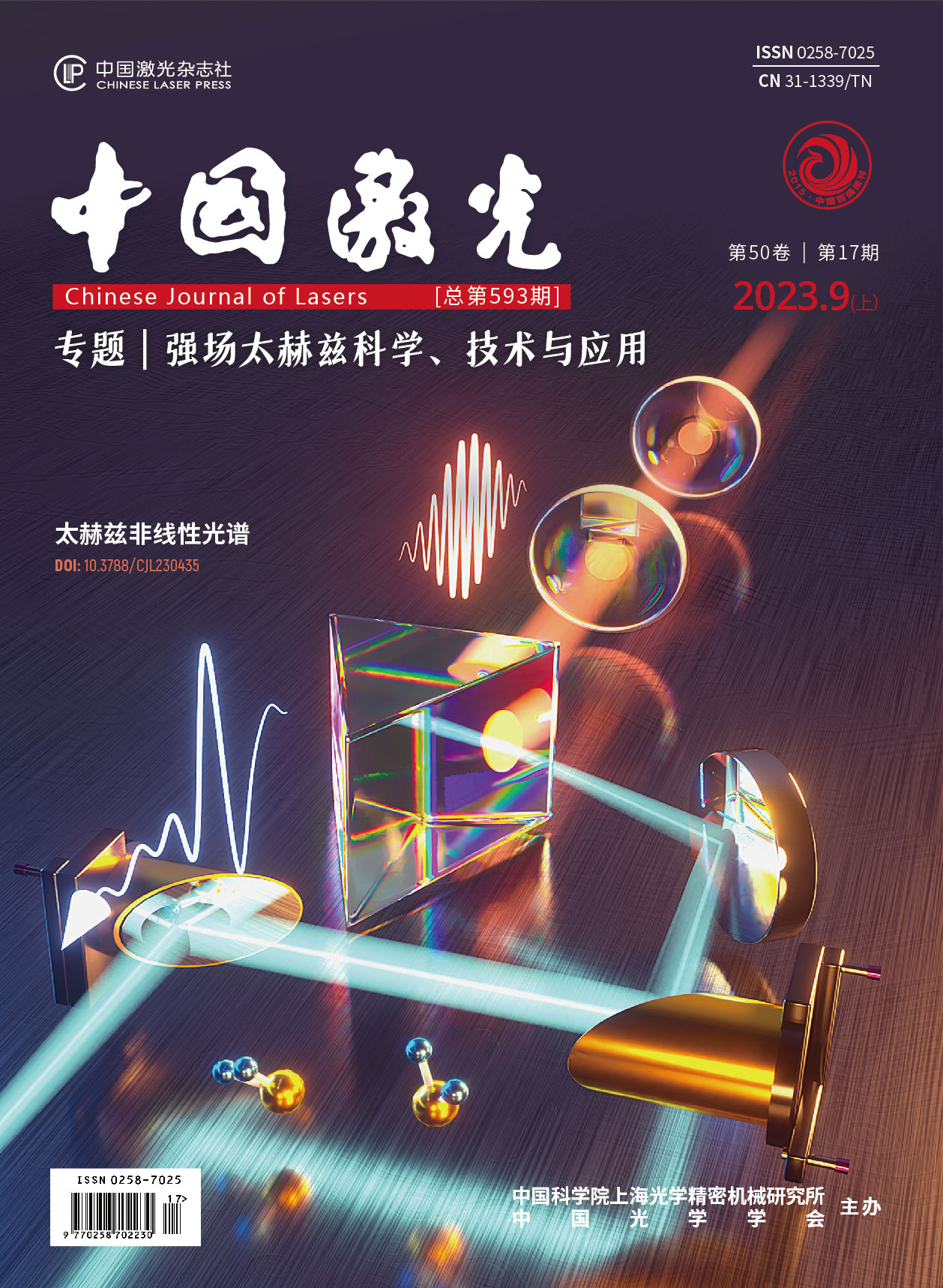铌酸锂强场太赫兹非线性时域光谱系统  下载: 878次封面文章
下载: 878次封面文章
The strong-field terahertz (THz) time-domain spectroscopy is fundamental in strong-field THz science, technology, and applications. Strong-field THz time-domain spectroscopy is also indispensable in many fields including materials, physics, chemistry, and biology, which involve strong nonlinear interactions between strong-field THz and matter. However, the unavailability of a high-field free-space THz source with high repetition rate, excellent beam quality, and high stability hinders its development. In this study, we designed and independently developed a highly integrated strong-field THz nonlinear time-domain spectroscopy system based on a lithium niobate (LN) strong-field THz source. The proposed system is driven by a kilohertz femtosecond laser amplifier and exhibits the functions of a strong-field THz nonlinear spectrum, THz-pump THz probe (TPTP), strong-field THz-pump optical probe, optical-pump THz probe (OPTP), and THz emission spectrum. This highly integrated strong-field THz nonlinear time-domain spectroscopy system is a powerful tool for analyzing the nonlinear effects of strong-field THz waves.
We developed a strong-field THz nonlinear time-domain spectroscopy system. We employed a Ti∶sapphire femtosecond laser amplifier that provided laser pulses with a center frequency of 800 nm, pulse duration of 35 fs, repetition rate of 1 kHz, and maximum pump power of 5 mJ. The laser input to the system was split using an 80∶20 beam splitter. The transmitted beam (80%) was employed as a pump beam to generate strong-field THz waves from the LN crystal through optical rectification based on the tilted pulse front technique. The strong-field THz waves generated by the LN crystal was used to induce and probe the nonlinear effects. The residual 20% femtosecond laser energy was divided into three beams: the first for the optical pump, the second for generating a weak-field THz probing beam in a ZnTe emission crystal (ZnTe 1), and the third for electro-optic sampling of both the pump and probing THz temporal waveforms. Three delay lines were employed to synchronize the strong-field THz, optical pump, and electro-optic sampling. THz temporal waveforms were detected by an electro-optic sampling system consisting of a ZnTe crystal, quarter-wave plate, Wollaston prism, and two photodiodes for the coherent detection of THz pulses based on the principle of the electro-optic effect.
In this work, the study on LN strong-field THz nonlinear spectroscopy is summarized as follows. First, for the strong-field THz generation and detection system (Fig. 2), the energy conversion efficiency of near-infrared light to THz waves was approximately 0.22%. At the focus of off-axis parabolic mirror 2 (OAP2), the calculated peak electric field can reach 350 kV/cm. The focused THz beam profile can be detected using a THz camera and temperature-sensitive paper. Based on this strong-field THz static nonlinear spectroscopy system, we observed the nonlinear absorption caused by the intervalley scattering of doped silicon induced by strong-field THz using the Z-scan technique (Fig. 3). In addition, the strong-field THz-induced nonlinear transmission self-frequency modulation of the THz nonlinear metasurface further demonstrates the excellent ability of strong-field THz nonlinear spectroscopy in the frequency domain (Fig. 4).
Second, the pump-probe technique is an essential research method for performing strong-field THz nonlinear spectroscopy. The TPTP technique can be achieved by introducing a THz probing beam generated by a ZnTe emission crystal, a coaxially aligned THz pump (generated by LN), and a THz probe, followed by focusing on the sample with an off-axis parabolic mirror (Fig. 5). The THz probing beam was modulated by a chopper with a 500 Hz rotor frequency to obtain a pure probing signal. A THz polarizer was positioned behind the sample with its polarizing orientation perpendicular to the THz pump to further restrict the transmitted THz pump. Using the TPTP technology with a spectral resolution, we observed dynamic changes in the resonant frequency of the THz probe transmission spectra induced by a strong THz field on nonlinear THz metasurface samples. This phenomenon demonstrates that carrier production in this SRRs sample is caused by the impact ionization of high-resistance silicon.
Third, we realized the OPTP technique by introducing an 800 nm pumping beam. The strong-field THz waves generated by the LN crystal can be used as the probing beam. By adjusting the incident THz field strength, the transmission signal self-modulation induced by the strong-field THz under an 800 nm pump is measured (Fig. 6). For more common OPTP applications, the weak-field THz generated by the ZnTe emission crystal is used as the probing beam, which is primarily used to investigate the ultrafast dynamics of carriers in semiconductors (Fig. 7). By adding a spectral resolution, the photoexcitation dynamics with different frequencies can be analyzed more comprehensively.
Finally, the proposed strong-field THz nonlinear time-domain spectroscopy system exhibits THz emission spectral capability. When stimulated by a femtosecond laser, the induced THz pulse carries a significant amount of physical information in its waveform. Taking the spin THz emission as an example, we demonstrate the flexibility of the system in examining the emission characteristics of the W/CoFeB/Pt thin-film structure (Fig. 8).
Strong-field THz nonlinear spectroscopy has become a critical method for studying the nonequilibrium behaviors resulting from strong THz-matter interactions. Based on the self-developed LN strong-field THz nonlinear-time-domain spectroscopy system, various experimental methods of strong-field THz nonlinear spectroscopy were studied and explained, demonstrating the unique ability and essential role of strong-field THz nonlinear spectroscopy in basic research. In addition, with a slight adjustment, the system can also be used for two-dimensional THz spectroscopy, THz electron acceleration, and the THz Kerr effect. This highly integrated and miniaturized THz time-domain spectrometer provides comprehensive research capabilities and potential for nonlinear THz spectroscopy in physics, materials, biology, and engineering applications.
才家华, 张保龙, 耿春艳, 郝思博, 陈赛, 吴晓君. 铌酸锂强场太赫兹非线性时域光谱系统[J]. 中国激光, 2023, 50(17): 1714012. Jiahua Cai, Baolong Zhang, Chunyan Geng, Sibo Hao, Sai Chen, Xiaojun Wu. Lithium Niobate Strong‑Field Terahertz Nonlinear Time‑Domain Spectroscopy System[J]. Chinese Journal of Lasers, 2023, 50(17): 1714012.







